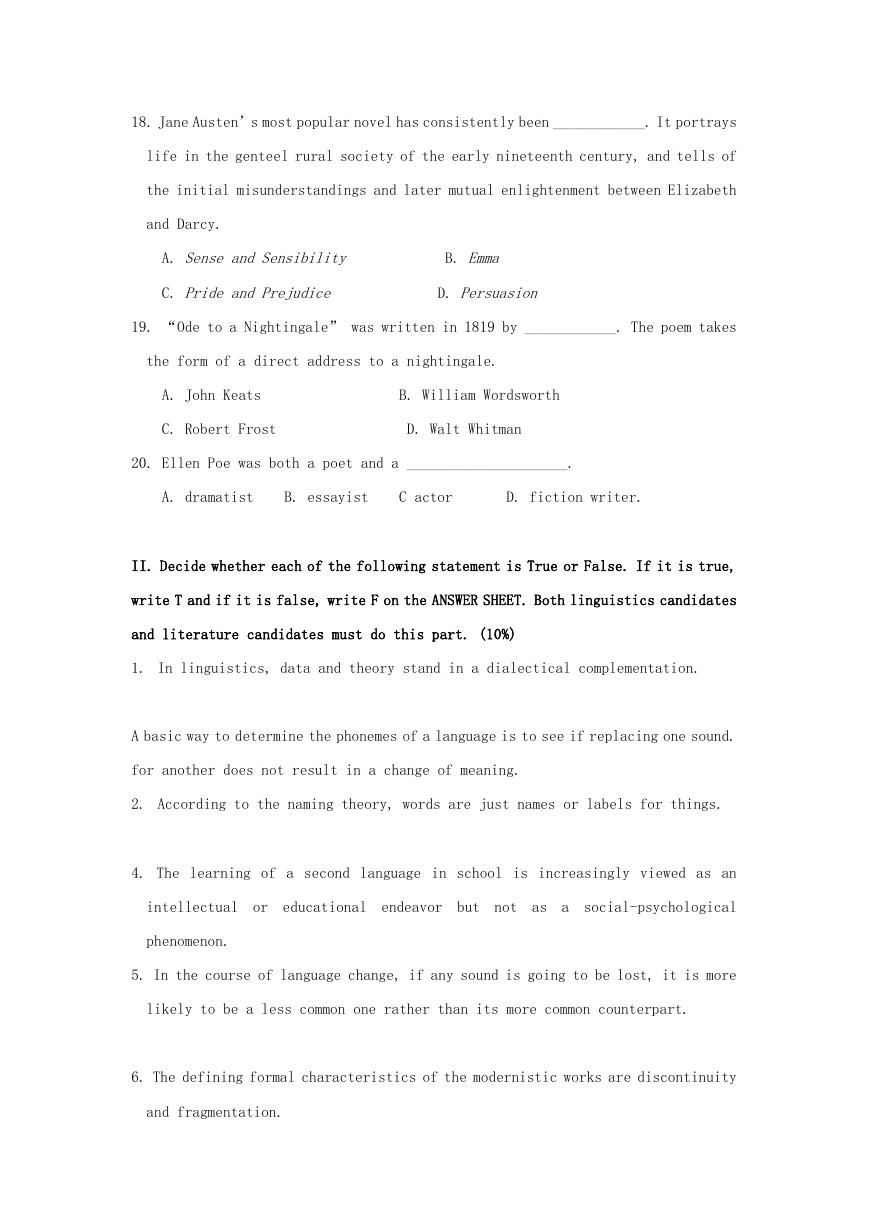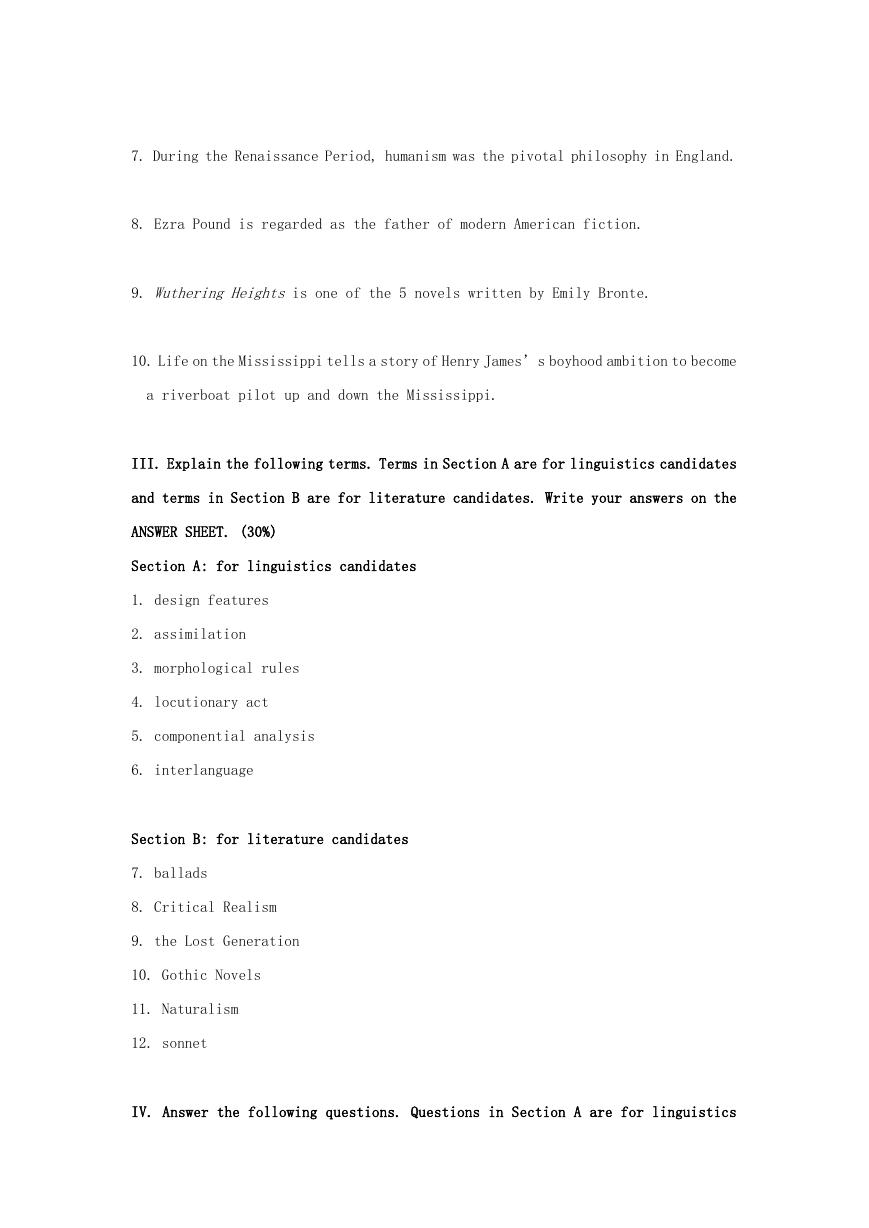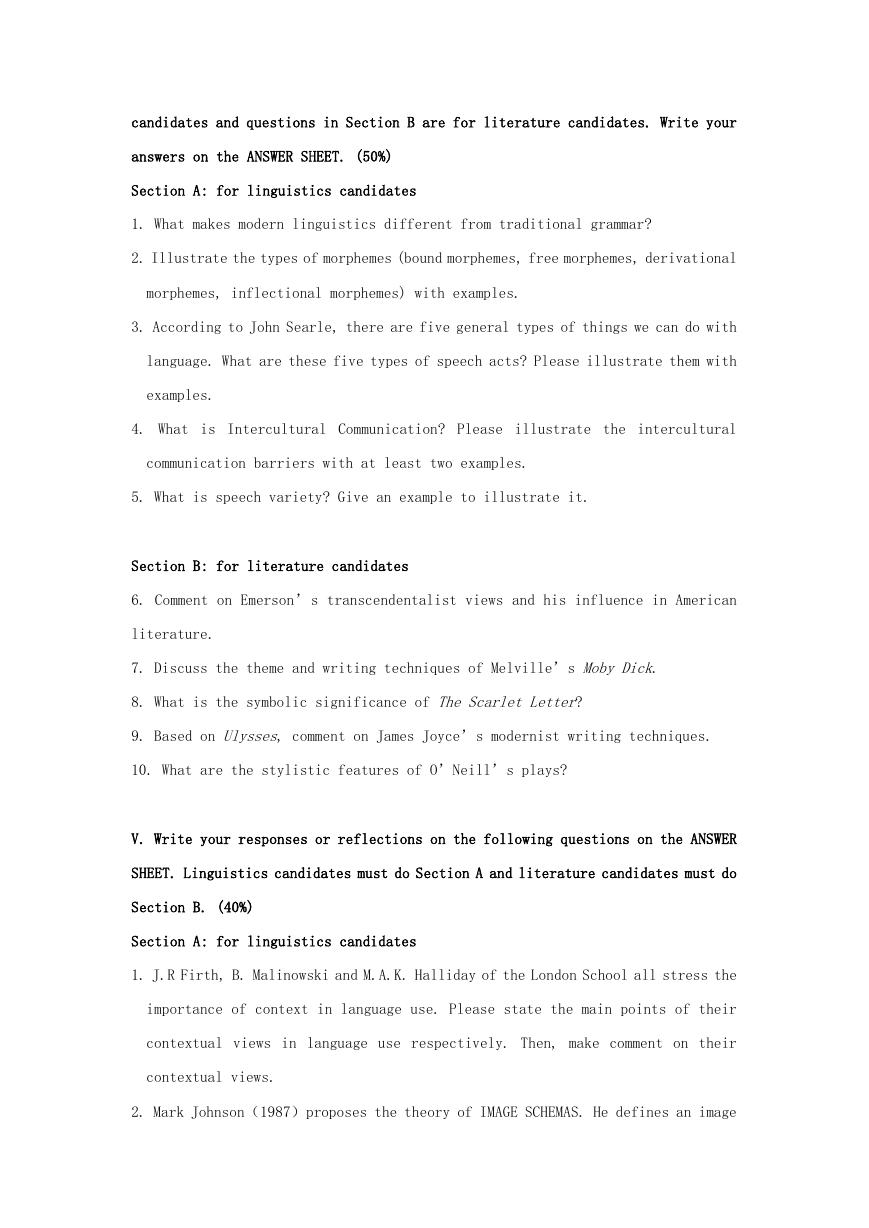2020 年广东暨南大学外国语言文学综合考研真题
招生专业与代码:外国语言文学 0502 (涵盖英语语言文学 050201、外国语言学及应用语言
学 050211)
考试科目名称及代码:808 外国语言文学综合考试
考生注意:所有答案必须写在答题纸(卷)上,写在本试题上一律不给分。
I. Multiple choice. There are 20 questions in this part. Choose the best answer
to each question. Write your answers on the ANSWER SHEET. Both linguistics
candidates and literature candidates must do this part. (20%)
1. The ________ of stress in English distinguishes meaning.
A. articulation
B. location
C. manner
D. organ
2. The English vowels can be classified according to the ________ of the sound.
A. height
B. length
C. width
D. shortage
3. English words are pronounced alike but spelled differently are called ________.
A. coordinates
B. homonymies
C. homophones
D. superordinates
4. The ability to use any word in a sentence requires knowledge of its ________.
A. lexical category
B. complementary distribution
C. syntactic rule
D. morphological awareness
5. The morpheme ‘-ed’ in the word ‘collected’ is a(n) ________.
A. bound morpheme
B. derivational morpheme
C. inflectional morpheme
D. free morpheme
6. Nouns, verbs and adjectives are referred to as ________.
A. content words
B. grammatical words
C. function words
D. formative words
7. The sentences ‘The lion licked the trainer’ and ‘The trainer licked the lion’
have the same number of words but different in meaning because the ________
assigned to each word is different.
A. deep structure
B. part of speech
C. surface structure
D. semantic
role
8. The core of the word and the major component of the meaning of the word is
�
constituted by its ________.
A. affix
B. base
C. root
D. stem
9. In the classic semantic triangle proposed by Ogden and Richards (1923), ________
refers to the object of experience.
A. reference
B. referent
C. thought
D. symbol
10. The application of the methods and results of linguistic research to such areas
as language teaching, translation, and language in advertising, classrooms, and
courts etc. is called ________.
A. Psycholinguistic
B. Cognitive Linguistics
C. Applied Linguistics
D. Comparative Linguistics
11. In ARoseforEmily, Faulkner makes best use of the _______ devices in narration.
A. Romantic
B. Realistic
C. Gothic
D. Modernist
12. All of the following books were written by Earnest Hemingway EXCEPT
A. The Old Man and the Sea
B. For Whom the Bell Tolls
C. The Sun Also Rises
D. Tales of the Jazz Age
13. John Milton is a great poet in the ____________ Period.
A. Anglo-Saxon Period
B. Renaissance
C. Pre-Romantic Period
D. Romantic
14. Shakespeare wrote
___________sonnets.
A. 125
B. 154
C. 245
D. 138
15. Nathaniel Hawthorne’s view of man and human history originates in ___________.
A. Transcendentalism
B. Naturalism
C. Puritanism
D. Romanticism
16.Whitman is radically innovative in terms of form of his poetry. The form of poetry
he preferred for the new subjects and new feelings is ____________.
A. epic
B. blank verse
C. heroic couplet
D. free verse
17. All of the following books were written by Mark Twain EXCEPT _________.
A. Life on the Mississippi
B. The Adventures of Huckleberry Finn
C. The Portrait of a Lady
D. The Gilded Age
�
18. Jane Austen’s most popular novel has consistently been ____________. It portrays
life in the genteel rural society of the early nineteenth century, and tells of
the initial misunderstandings and later mutual enlightenment between Elizabeth
and Darcy.
A. Sense and Sensibility
B. Emma
C. Pride and Prejudice
D. Persuasion
19. “Ode to a Nightingale” was written in 1819 by ____________. The poem takes
the form of a direct address to a nightingale.
A. John Keats
B. William Wordsworth
C. Robert Frost
D. Walt Whitman
20. Ellen Poe was both a poet and a _____________________.
A. dramatist
B. essayist
C actor
D. fiction writer.
II. Decide whether each of the following statement is True or False. If it is true,
write T and if it is false, write F on the ANSWER SHEET. Both linguistics candidates
and literature candidates must do this part. (10%)
1. In linguistics, data and theory stand in a dialectical complementation.
A basic way to determine the phonemes of a language is to see if replacing one sound.
for another does not result in a change of meaning.
2. According to the naming theory, words are just names or labels for things.
4. The learning of a second language in school is increasingly viewed as an
intellectual or educational endeavor but not as a social-psychological
phenomenon.
5. In the course of language change, if any sound is going to be lost, it is more
likely to be a less common one rather than its more common counterpart.
6. The defining formal characteristics of the modernistic works are discontinuity
and fragmentation.
�
7. During the Renaissance Period, humanism was the pivotal philosophy in England.
8. Ezra Pound is regarded as the father of modern American fiction.
9. Wuthering Heights is one of the 5 novels written by Emily Bronte.
10. Life on the Mississippi tells a story of Henry James’s boyhood ambition to become
a riverboat pilot up and down the Mississippi.
III. Explain the following terms. Terms in Section A are for linguistics candidates
and terms in Section B are for literature candidates. Write your answers on the
ANSWER SHEET. (30%)
Section A: for linguistics candidates
1. design features
2. assimilation
3. morphological rules
4. locutionary act
5. componential analysis
6. interlanguage
Section B: for literature candidates
7. ballads
8. Critical Realism
9. the Lost Generation
10. Gothic Novels
11. Naturalism
12. sonnet
IV. Answer the following questions. Questions in Section A are for linguistics
�
candidates and questions in Section B are for literature candidates. Write your
answers on the ANSWER SHEET. (50%)
Section A: for linguistics candidates
1. What makes modern linguistics different from traditional grammar?
2. Illustrate the types of morphemes (bound morphemes, free morphemes, derivational
morphemes, inflectional morphemes) with examples.
3. According to John Searle, there are five general types of things we can do with
language. What are these five types of speech acts? Please illustrate them with
examples.
4. What is Intercultural Communication? Please illustrate the intercultural
communication barriers with at least two examples.
5. What is speech variety? Give an example to illustrate it.
Section B: for literature candidates
6. Comment on Emerson’s transcendentalist views and his influence in American
literature.
7. Discuss the theme and writing techniques of Melville’s Moby Dick.
8. What is the symbolic significance of The Scarlet Letter?
9. Based on Ulysses, comment on James Joyce’s modernist writing techniques.
10. What are the stylistic features of O’Neill’s plays?
V. Write your responses or reflections on the following questions on the ANSWER
SHEET. Linguistics candidates must do Section A and literature candidates must do
Section B. (40%)
Section A: for linguistics candidates
1. J.R Firth, B. Malinowski and M.A.K. Halliday of the London School all stress the
importance of context in language use. Please state the main points of their
contextual views in language use respectively. Then, make comment on their
contextual views.
2. Mark Johnson(1987)proposes the theory of IMAGE SCHEMAS. He defines an image
�
schema as a recurring pattern of our perceptual interactions and motor programs
that gives coherence and structure to our experience. You are expected to develop
the theory of IMAGE SCHEMAS by making comment.
(1) What are the two characteristics of image schematic structures?
(2) Define the following image schemas and illustrate them with examples.
1)A center-periphery schema
2)A containment schema
3)A cycle schema
4)A force schema
5)A link Schema
6)A part-whole schema
7)A path schema
8)A scale schema
9)A verticality schema
(3) Make comment on Mark Johnson’s Theory of Image Schemas.
Section B: for literature candidates
3. Based on Emily Bronte ’ s Wuthering Heights, discuss the theme and writing
techniques of this novel.
4. Analyze the theme, poetic form and rhetorical devices of the following poem and
develop it into an essay.
Because I Could Not Stop for Death
Because I could not stop for Death –
He kindly stopped for me –
The Carriage held but just Ourselves –
And Immortality.
We slowly drove – He knew no haste
�
And I had put away
My labor and my leisure too,
For His Civility ---
We passed the School, where Children strove
At Recess – in the Ring –
We passed the fields of Gazing Grain
---
We passed the Setting Sun –
Or rather – He passed Us –
The Dews drew quivering and chill –
For only Gossamer, my Gown –
My Tippet – only Tulle –
We paused before a House that seemed
A Swelling of the Ground –
The Roof was scarcely visible –
The Cornice – in the Ground –
Since then – ‘tis Centuries – and yet
Feels shorter than the Day
I first surmised the Horses’ Heads
Were Toward Eternity ---
�














 2023年江西萍乡中考道德与法治真题及答案.doc
2023年江西萍乡中考道德与法治真题及答案.doc 2012年重庆南川中考生物真题及答案.doc
2012年重庆南川中考生物真题及答案.doc 2013年江西师范大学地理学综合及文艺理论基础考研真题.doc
2013年江西师范大学地理学综合及文艺理论基础考研真题.doc 2020年四川甘孜小升初语文真题及答案I卷.doc
2020年四川甘孜小升初语文真题及答案I卷.doc 2020年注册岩土工程师专业基础考试真题及答案.doc
2020年注册岩土工程师专业基础考试真题及答案.doc 2023-2024学年福建省厦门市九年级上学期数学月考试题及答案.doc
2023-2024学年福建省厦门市九年级上学期数学月考试题及答案.doc 2021-2022学年辽宁省沈阳市大东区九年级上学期语文期末试题及答案.doc
2021-2022学年辽宁省沈阳市大东区九年级上学期语文期末试题及答案.doc 2022-2023学年北京东城区初三第一学期物理期末试卷及答案.doc
2022-2023学年北京东城区初三第一学期物理期末试卷及答案.doc 2018上半年江西教师资格初中地理学科知识与教学能力真题及答案.doc
2018上半年江西教师资格初中地理学科知识与教学能力真题及答案.doc 2012年河北国家公务员申论考试真题及答案-省级.doc
2012年河北国家公务员申论考试真题及答案-省级.doc 2020-2021学年江苏省扬州市江都区邵樊片九年级上学期数学第一次质量检测试题及答案.doc
2020-2021学年江苏省扬州市江都区邵樊片九年级上学期数学第一次质量检测试题及答案.doc 2022下半年黑龙江教师资格证中学综合素质真题及答案.doc
2022下半年黑龙江教师资格证中学综合素质真题及答案.doc